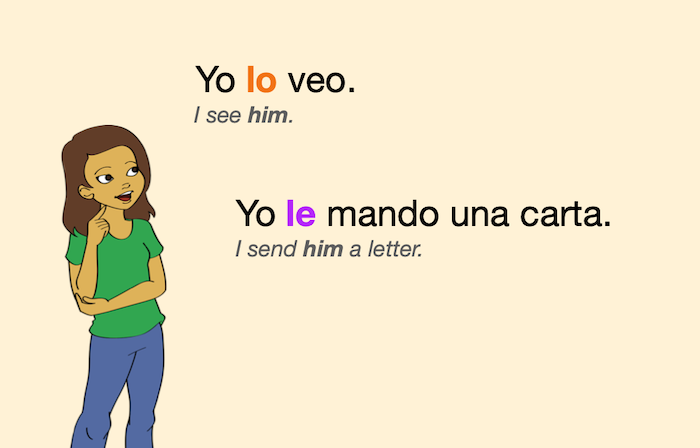Welcome 😊 to our grammar lesson on Spanish object pronouns.
In this lesson we will talk about both direct and indirect object pronouns (“complemento directo” and “complemento indirecto”).

By the end, you will be able to identify Spanish object pronouns and use them correctly in sentences.
You will also find a Quiz and Exercises to practice.
For clarity, we will keep the color orange for direct and purple for indirect.
Contents
Object pronouns – Forms
During this lesson, we are talking about the following 2 sets of pronouns:
Direct object pronouns
| Spanish | English |
|---|---|
| me | me |
| te | you |
| lo, la | him, her (both can also mean "it" or formal "you") |
| nos | us |
| os | you guys |
| los, las | them (both can also mean formal plural "you") |
Indirect object pronouns
| Spanish | English |
|---|---|
| me | me |
| te | you |
| le | him, her, it, formal "you" |
| nos | us |
| os | you guys |
| les | them, formal plural "you" |
As we notice in the tables above, direct and indirect pronouns have almost identical forms. The only difference is in the third persons, where direct pronouns distinguish between genders (lo-la, los-las) and indirect pronouns don’t.
Use of direct object pronouns
Direct object pronouns represent the person or thing directly receiving the action of the verb. For example, in the English sentence “Do you love me?”, “me” is a direct object pronoun.
¿Tú me quieres?
Do you love me?Sí, te quiero.
Yes, I love you.Laura nos conoce.
Laura knows us.Nosotros os vemos.
We see you guys.
The pronouns lo, la, los and las usually replace a noun. To choose between them, we need to consider the gender and number of that noun:
¿Conocéis a Miguel?
Do you guys know Miguel?
Sí, lo conocemos.
Yes, we know him. (“lo” represents “Miguel”, which is masculine singular)¿Tú tienes la revista?
Do you have the magazine?
Sí, yo la tengo en mi casa.
Yes, I have it in my house. (“la revista” is feminine singular)¿Has leído los libros?
Have you read the books?
No, no los he leído.
No, I haven’t read them. (“los libros” is masculine plural)¿Compra él las botellas?
Does he buy the bottles?
Sí, él las compra.
Yes, he buys them. (“las botellas” is feminine plural)
Use of indirect object pronouns
Indirect object pronouns represent the person or thing indirectly receiving the action of the verb. In other words, to whom or for whom the action is done. For example, in the sentence “I send her a letter”, “her” is an indirect object pronoun (not what I send, but to whom I send it).
¿Me has mandado la carta?
Have you sent me the letter?Sí, te he mandado la carta.
Yes, I have sent you the letter.Yo le doy un beso.
I give her a kiss.Nuestra madre nos cuenta un cuento.
Our mother tells us a story.¿Qué os han dicho?.
What have they told you guys?Nosotros les llevamos bebidas.
We bring drinks to them.
Placement in the sentence
In order to place object pronouns correctly in the sentence, we need to consider the tense of the verb they are connected with.
Depending of the tense, object pronouns can occupy two different spots:
- Right before the verb, written separately
- Attached at the end of the verb
Let’s study both possibilities:
1. Right before the verb, written separately
This happens when the verb is conjugated in any tense with the exception of the Infinitive, Gerundio and Affirmative Commands.
Marta lo sabe.
Marta knows it. (present tense)Yo les he comprado un coche.
I have bought them a car. (present perfect)Ella nos llamó.
She called us. (preterite tense)No me insultes.
Don’t insult me. (negative command).Nosotros os contaremos un chiste.
We will tell you guys a joke. (future tense)Tú le mandarías una carta.
You would send him a letter. (conditional tense)
2. Attached at the end of the verb
We attach object pronouns at the end of verbs in the Infinitive or Gerundio, and also of Affirmative Commands.
Mandarles la carta es importante.
Sending them the letter is important. (infinitive)Yo estoy comprándolos.
I’m buying them. (gerundio)Hazlo.
Do it. (affirmative command)
When we have 2 verbs combined
Some sentences have 2 verbs combined in the following way:
- The first verb is a conjugated verb
- The second verb is in Infinitive or Gerundio
In this case, we have the freedom to place the pronouns either before the first verb (written separately), or attached at the end of the second verb:
Yo lo estoy haciendo.
Yo estoy haciéndolo.
Both sentences mean “I’m doing it”.
Os queremos dar un regalo.
Queremos daros un regalo.
Both mean “We want to give you guys a present”.Tú la vas a comprar.
Tú vas a comprarla.
Both mean “You are going to buy it”.
Sentences with 2 object pronouns
There are sentences that include 2 object pronouns: one indirect and one direct.
When this happens, we place the pronouns in that order: first indirect, then direct.
The rest of the rules in this lesson still apply. We place the pronouns either before the verb (written separately) or attached at the end, depending on the tense as we have learned.
Yo te lo digo.
I say it to you. (present tense)Dímelo
Say it to me. (affirmative command)
Special case where “le” or “les” becomes “se”
le and les become se when they are placed right before lo, la, los or las.
Yo se las he mandado.
I have sent them to him. (instead of“le las he mandado”)Juan quiere decírselo.
Juan wants to say it to them. (instead of“decírleslo”)
Practice
Quiz
Take this short Quiz about Object Pronouns:
Exercise 1
In the following dialogs, fill the gaps using Spanish direct object pronouns. Click on the gray spaces to see the solutions:
1) Álvaro, ¿tienes mi móvil?
Álvaro, do you have my cell phone?
Sí, lo tengo.
Yes, I have it.2) ¿Sabes la respuesta a esta pregunta?
Do you know the answer to this question?
No, no la sé.
No, I don’t know it.3) ¿Has puesto las tijeras sobre la mesa?
Have you put the scissors on the table?
Sí, las he puesto ahí.
Yes, I’ve put them there.4) ¿Me quieres?
Do you love me?
Sí, te quiero.
Yes, I love you.5) ¿Habéis comprado las patatas?
Have you guys bought the potatoes?
Sí, las hemos comprado.
Yes, we have bought them.6) ¿Tú nos oyes?
Do you hear us?
Sí, os oigo perfectamente.
Yes, I hear you guys perfectly.
Exercise 2
In the following sentences, fill the gaps using Spanish indirect object pronouns:
1) Yo te he mandado la carta.
I have sent you the letter.
2) Ana nos enseña su casa.
Ana shows us her house.3) Luis le compra un regalo.
Luis buys her a present.4) Él me da el lápiz.
He gives me the pencil.5) Yo les cuento una historia.
I tell them a story.6) El vendedor os enseña el coche.
The seller shows you guys the car.
Exercise 3
In the following dialogs, fill the gaps using object pronouns (direct or indirect).
In some cases you might need to use 2 pronouns, or a verb with pronouns attached at the end:
1) ¿Me amas?
Do you love me?
Sí, te amo.
Yes, I love you.2) ¿Estás haciendo las camas?
Are you making the beds?
Sí, estoy haciéndolas.
Yes, I’m making them.3) ¿Me has mandado el correo?
Have you sent me the email?
Sí, te lo he mandado.
Yes, I have sent it to you.4) ¿Le habéis dado el regalo?
Have you guys given him the present?
Sí, se lo hemos dado.
Yes, we have given it to him.5) ¿Vais a explicarme el problema?
Are you guys going to explain the problem to me?
Sí, vamos a explicártelo.
Yes, we are going to explain it to you.6) ¿Nos vas a llamar?
Are you going to call us?
Sí, voy a llamaros.
Yes, I’m going to call you guys.7) ¿Quieres contarles la historia?
Do you want to tell them the story?
Sí, quiero contársela.
Yes, I want to tell it to them.








